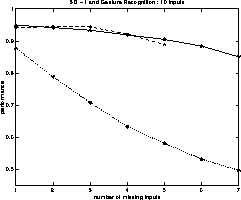Experimental Results



Next: Training (Backpropagation)
Up: Missing Information During
Previous: An Efficient Approximation
We tested our algorithm using the same data as in Ahmad and Tresp, 1993.
The task was to recognize a hand gesture based on its 2D projection.
As input, the classifier is given the 2D polar coordinates of the five
finger tip positions relative to the 2D center of mass of the hand
(the input space is therefore 10-D). A multi-layer perceptron was
trained on 4368 examples (624 poses for each gesture) and tested on a
similar independent test set. The inputs were normalized to a variance
of one and  was set to 0.1. (For a complete description of
the task see (Ahmad and Tresp, 1993).) As in
(Ahmad & Tresp, 1993) we defined a correct classification as one
in which the correct class was either classified as the most
probable or the second most probable. Figure 2 shows
experimental results. On the horizontal axis, the number of
randomly chosen missing inputs is shown. The continuous line shows
the performance using Equation 2 where we used only the
10 nearest neighbors in the approximation. Even with 5 missing inputs
we obtain a score of over 90 % which is slightly better than the solution
we obtained in Ahmad and Tresp (1993) for normalized RBFs.
We expect our new solution to perform very well in general
since we can always choose the best network for prediction and are not restricted in the architecture.
As a benchmark we also included the case where the mean of the missing input
was substituted. With 5 missing inputs, the performance is less than
60 %.
was set to 0.1. (For a complete description of
the task see (Ahmad and Tresp, 1993).) As in
(Ahmad & Tresp, 1993) we defined a correct classification as one
in which the correct class was either classified as the most
probable or the second most probable. Figure 2 shows
experimental results. On the horizontal axis, the number of
randomly chosen missing inputs is shown. The continuous line shows
the performance using Equation 2 where we used only the
10 nearest neighbors in the approximation. Even with 5 missing inputs
we obtain a score of over 90 % which is slightly better than the solution
we obtained in Ahmad and Tresp (1993) for normalized RBFs.
We expect our new solution to perform very well in general
since we can always choose the best network for prediction and are not restricted in the architecture.
As a benchmark we also included the case where the mean of the missing input
was substituted. With 5 missing inputs, the performance is less than
60 %.

Figure: Experimental results using a generalization data set.
The continuous line indicates the performance using
our proposed method.
The dotted lines indicate the performance if the mean of the missing input
variable is substituted.
As a comparison, we included the results obtained in Ahmad and Tresp (1993)
using the closed-form solution for RBF-networks (dashed).



Next: Training (Backpropagation)
Up: Missing Information During
Previous: An Efficient Approximation
Subutai Ahmad
Mon Mar 27 18:14:29 PST 1995
 was set to 0.1. (For a complete description of
the task see (Ahmad and Tresp, 1993).) As in
(Ahmad & Tresp, 1993) we defined a correct classification as one
in which the correct class was either classified as the most
probable or the second most probable. Figure 2 shows
experimental results. On the horizontal axis, the number of
randomly chosen missing inputs is shown. The continuous line shows
the performance using Equation 2 where we used only the
10 nearest neighbors in the approximation. Even with 5 missing inputs
we obtain a score of over 90 % which is slightly better than the solution
we obtained in Ahmad and Tresp (1993) for normalized RBFs.
We expect our new solution to perform very well in general
since we can always choose the best network for prediction and are not restricted in the architecture.
As a benchmark we also included the case where the mean of the missing input
was substituted. With 5 missing inputs, the performance is less than
60 %.
was set to 0.1. (For a complete description of
the task see (Ahmad and Tresp, 1993).) As in
(Ahmad & Tresp, 1993) we defined a correct classification as one
in which the correct class was either classified as the most
probable or the second most probable. Figure 2 shows
experimental results. On the horizontal axis, the number of
randomly chosen missing inputs is shown. The continuous line shows
the performance using Equation 2 where we used only the
10 nearest neighbors in the approximation. Even with 5 missing inputs
we obtain a score of over 90 % which is slightly better than the solution
we obtained in Ahmad and Tresp (1993) for normalized RBFs.
We expect our new solution to perform very well in general
since we can always choose the best network for prediction and are not restricted in the architecture.
As a benchmark we also included the case where the mean of the missing input
was substituted. With 5 missing inputs, the performance is less than
60 %.
